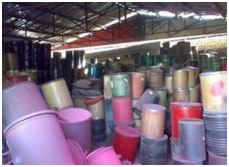Innovative Indigo Tie Dye Solutions for Creative Fashion and Home Decor Projects
The Art and Craft of Indigo Tie Dye Products
Indigo tie dye, a timeless textile art form, has captured the hearts and imaginations of artisans and enthusiasts around the globe. Rooted in ancient traditions, indigo tie dyeing offers a unique blend of creativity, cultural significance, and sustainable practices. This article delves into the fascinating world of indigo tie dye products, exploring their history, techniques, and the modern resurgence of this craft.
A Brief History of Indigo Dyeing
Indigo dyeing has a rich history that dates back thousands of years. The indigo plant, primarily from the genus Indigofera, has been prized for its deep blue pigment. The dyeing process is deeply embedded in various cultures, with ties to regions such as Asia, Africa, and the Americas. In Japan, shibori is a tie dye technique that dates back to the 8th century, while in West Africa, beautifully patterned indigo fabrics have been traditionally made by artisans for generations.
The process of tie dyeing itself involves binding, twisting, or folding fabric in specific ways before dipping it into an indigo dye bath. The areas that are tied off resist the dye, resulting in beautiful, patterned designs. The unique characteristics of the indigo dye create stunning color variations that can change with each use, making every piece a one-of-a-kind work of art.
Techniques of Indigo Tie Dyeing
There are various techniques employed in creating indigo tie dye products, each contributing to the distinct aesthetics of the finished fabric. Some popular methods include
1. Shibori This traditional Japanese technique involves folding, twisting, and binding fabric to create intricate patterns. The fabric is then dyed, resulting in complex designs that range from simple to highly detailed.
2. Bound List In this method, fabric is bound tightly at intervals with string or rubber bands, creating circular patterns. The places that are tightly bound remain undyed, producing striking contrasts.
3. The Pole-Wrapping Technique A modern favorite, this technique involves wrapping fabric around a pole and binding it at various points to create spiral or striped patterns. The fabric is then immersed in indigo dye, leading to a gradient effect.
indigo tie dye products

4. Resistance Dyeing This method employs different techniques to resist the dye, such as using wax, where the waxed areas remain undyed. This adds depth and texture to the final product.
The Resurgence of Indigo Tie Dye Products
In recent years, there has been a significant resurgence in interest in indigo tie dye products. This revival can be attributed to several factors
- Sustainability As consumers become more conscious of their environmental impact, many are opting for natural dyes like indigo over synthetic alternatives. Indigo dyeing is seen as a sustainable practice that supports local artisans and promotes eco-friendly fashion.
- Individuality In a world dominated by mass production, indigo tie dye products stand out for their uniqueness. Each piece is distinct, allowing individuals to express their personal style through one-of-a-kind garments and textiles.
- Cultural Appreciation The appreciation for traditional crafts has grown, leading to a renewed interest in learning these techniques. Workshops and classes are widely accessible, attracting people eager to explore their creative sides and create lasting, meaningful pieces.
The Future of Indigo Tie Dyeing
The future of indigo tie dye products looks bright, as more artisans and designers innovate within this age-old craft. Contemporary fashion brands are embracing tie dye aesthetics, integrating indigo hues into modern designs while respecting traditional techniques. The combination of old and new creates exciting opportunities for collaboration and innovation.
In essence, indigo tie dye products represent more than just beautiful textiles; they embody a rich history, a commitment to sustainability, and an endless source of creativity. Whether you are a seasoned artisan or a newcomer to the craft, the world of indigo tie dye invites you to explore, experiment, and create. As we embrace the artistry of indigo, we not only celebrate its past but also pave the way for its future in fashion and design.
-
The Timeless Art of Denim Indigo Dye
NewsJul.01,2025
-
The Rise of Sulfur Dyed Denim
NewsJul.01,2025
-
The Rich Revival of the Best Indigo Dye
NewsJul.01,2025
-
The Enduring Strength of Sulphur Black
NewsJul.01,2025
-
The Ancient Art of Chinese Indigo Dye
NewsJul.01,2025
-
Industry Power of Indigo
NewsJul.01,2025
-
Black Sulfur is Leading the Next Wave
NewsJul.01,2025

Sulphur Black
1.Name: sulphur black; Sulfur Black; Sulphur Black 1;
2.Structure formula:
3.Molecule formula: C6H4N2O5
4.CAS No.: 1326-82-5
5.HS code: 32041911
6.Product specification:Appearance:black phosphorus flakes; black liquid

Bromo Indigo; Vat Bromo-Indigo; C.I.Vat Blue 5
1.Name: Bromo indigo; Vat bromo-indigo; C.I.Vat blue 5;
2.Structure formula:
3.Molecule formula: C16H6Br4N2O2
4.CAS No.: 2475-31-2
5.HS code: 3204151000 6.Major usage and instruction: Be mainly used to dye cotton fabrics.

Indigo Blue Vat Blue
1.Name: indigo blue,vat blue 1,
2.Structure formula:
3.Molecule formula: C16H10N2O2
4.. CAS No.: 482-89-3
5.Molecule weight: 262.62
6.HS code: 3204151000
7.Major usage and instruction: Be mainly used to dye cotton fabrics.

